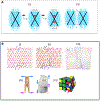Allostery in Its Many Disguises: From Theory to Applications
- PMID: 30744993
- PMCID: PMC6688844
- DOI: 10.1016/j.str.2019.01.003
Allostery in Its Many Disguises: From Theory to Applications
Abstract
Allosteric regulation plays an important role in many biological processes, such as signal transduction, transcriptional regulation, and metabolism. Allostery is rooted in the fundamental physical properties of macromolecular systems, but its underlying mechanisms are still poorly understood. A collection of contributions to a recent interdisciplinary CECAM (Center Européen de Calcul Atomique et Moléculaire) workshop is used here to provide an overview of the progress and remaining limitations in the understanding of the mechanistic foundations of allostery gained from computational and experimental analyses of real protein systems and model systems. The main conceptual frameworks instrumental in driving the field are discussed. We illustrate the role of these frameworks in illuminating molecular mechanisms and explaining cellular processes, and describe some of their promising practical applications in engineering molecular sensors and informing drug design efforts.
Keywords: Allostery; allosteric drugs; allosteric material; allosteric switches; elastic network models; energy landscape; molecular dynamics; protein conformational changes; protein function; regulation; signal transduction.
Copyright © 2019. Published by Elsevier Ltd.
Figures



References
-
- Amaro RE, Sethi A, Myers RS, Davisson VJ, and Luthey-Schulten ZA (2007). A network of conserved interactions regulates the allosteric signal in a glutamine amidotransferase. Biochemistry 46, 2156–2173. - PubMed
-
- Bahar I, Jernigan RL, and Dill K (2017). Protein Actions: Principles & Modeling (Taylor & Francis Group; ).

